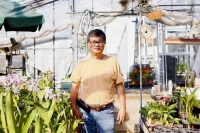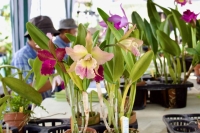Third-generation orchid farmer Munekazu Eriji has watched the fate of the flowers rise and fall, echoing Japan’s economy over the years. Now, like many of the nation’s business owners, he is looking for a successor who will take over his orchid empire.
But it’s not easy — the plants are a difficult business.
“I was hoping my son would take over — he was working here, but he quit. So that's my big headache now,” Eriji, who is also president of the Japan Orchid Growers Association, says.
Summer at his Chiba Prefecture farm, as in the rest of the country, is also getting hotter and longer, which has potentially devastating consequences. “We had a pretty hard time growing some kinds of orchids this year ... we lost some plants that couldn’t take (it),” he says.
Even under perfect conditions, it can be a slow, challenging process to grow orchids, but Eriji, who creates new hybrids, enjoys his work and is clearly a patient man. Pollinating two flowers into a seed takes a year, but it’s a seven- or eight-year process before plants reach maturity. Still, he says being able to delight people with the finished plant makes the process worthwhile.
Orchids are a mysterious plant and have long enraptured and enticed hobbyists and scientists. Hunting out their varied forms — an estimated 31,000 species — has even turned some into thieves. For those who love them, they can quickly become an obsession.
While most people are familiar with standard, commercially grown ornamental orchids — white flowers with stiff butterfly wing-esque forms and internal petals like tiny upside down drooping mustaches, with these often seen in Japan and other places outside newly opened shops or in funeral parlors — orchid collectors and enthusiasts like Eriji fixate on rare and unusual plants.
“Maybe my feelings are the same as a hobbyist — a hobbyist wants to collect rare plants. ... They have no interest in orchids being sold at the flower shop,” he says, recalling regular travels to study and observe plants all over the world — he counts 40 to 50 trips to South America alone.
While people such as Eriji grow their own plants and make legitimate sales, there is a dark side to this obsession, with the desire for ever-rarer varieties underpinning a robust illegal trade that is thought to be responsible for wiping out entire species. And this age-old business — which can see the flowers trucked over borders en masse or spirited away by individuals — has been given new momentum by social media.
While the Convention of International Trade in Endangered Species of Wild Fauna and Flora (CITES), which was signed 50 years ago, bans the trade of wild orchids, some jurisdictions are more active than others in enforcement.
Environmental and social scientist Jacob Phelps, who grew up in biodiverse Costa Rica, says that the vast majority of orchids that people buy from greenhouses in Japan are legitimate and legal.
“Very few of these are going to have conservation implications,” Phelps says, but this is not the case for plant markets and groups who are “either forging permits, or are omitting permits.”
In countries like Nepal, where orchid conservationist and Greenhood Nepal research fellow Reshu Bashyal works, and where the plants are harvested and mass exported for industries like traditional Chinese medicine, it is a more pressing issue.
Bashyal worked with the British government through its Illegal Wildlife Trade Challenge Fund to carry out a large-scale project that monitored harvesting in Nepal.
“I never thought the trade would be so big,” she said. “I saw a huge, huge quantity of orchids being collected for trade.”
If you have a mass collection of orchids, says Phelps, “you can eradicate not just a population, but an entire species without very much effort.”
A study published in 2020 found that in Bangladesh, of the 187 known orchid species native to the country, 32 had been wiped out. And following the 2009 discovery of Vietnamese orchid variety Paphiopedilum canhii — a delicate insect-like form — the commercial harvesting of 99.5% of its population occurred in just a few years.
Germination
While orchids themselves are complex, so is their history. Known as “daydream flowers,” in Europe in the 19th century, the plants were responsible for a frenzy known as “orchidelirium,” or orchid fever. With the wealthy possessing an insatiable hunger for new varieties, orchid hunters were employed and duels, theft and kidnapping ensued. Some theorized that people were drawn to an orchids’ symmetry, which mirrors that of the human face.
For Amy Hinsley, a wildlife trade-focused senior research fellow at Oxford University dubbed “orchid Amy” due to her research interests, it was that human element that first piqued her interest. “I was so interested in these flowers that could do that to people,” she says.
Japan’s own love of orchids also grew shortly after this period. Around that time, finance worker and adventurer Shotaro Kaga traveled to Europe, where he was inspired by the orchid culture he found. In 1914, he built a greenhouse at his Oyamazaki Villa in Kyoto Prefecture, importing various orchids from South America, the Philippines and Indonesia, as well as cultivating his own plants and publishing an illustrated book on the plants. Kaga is credited by some as playing a critical role in developing Japan’s current love of orchids.
Eriji’s grandfather, who had an office in Manhattan and used to be in the import business, bought the Chiba nursery before the start of World War II. Only invited guests were allowed to visit it.
“I heard people needed to (bring) some omiyage (souvenirs) for my grandfather” if they were to visit, Eriji says.
Eriji also says there are interesting parallels between orchid appreciation and economic prosperity, with the bubble era in Japan seeing an “orchid boom.”
Eriji has seen demand from China for high quality plants, but he is “not sure about China in the next few months,” given the country’s economic slowdown.
Still, “once a country becomes richer, people start buying orchids,” Eriji says.
The farmer first visited Southeast Asia 40 years ago, and at that time the region felt poor. But the countries there have since become richer and developed. “And then they started buying orchids,” he says.
Hinsley, who is sometimes contacted by writers of detective novels that reference orchid theft, says orchidelirium continues to this day. But while it’s “still that same kind of orchidelirium, orchid fever,” with hunger for new flowers driving that passion, this has “adapted to the 21st century.”
Hunters
Today’s orchid hunters are equipped with new tools. While the image of harvesting illegal orchids invokes sweat-drenched explorers trekking through the Amazon, and orchid hunters do still hunt in nature, now they are more likely to be sold on another kind of Amazon or other online marketplaces.
“Instead of the Victorian orchidelirium, where you would send a collector out, you can do your own orchid hunting online,” Hinsley says, noting that the online trade is also expanding the market.
Under the veil of anonymity, a variety of online tactics are deployed, from mislabeling to livestreaming with illicit orchids in frame to catch the eye of hunters.
While exports of live orchids are estimated to be worth around $2.51 billion (¥374.6 billion) annually, it’s difficult to quantify the global illegal trade. But in southern China alone, illicit sales involved more than 400 species and 1.2 million individuals and had a value of more than $14.6 million, a yearlong study found.
Much like orchids and their unique relationship with their pollinators, scientists and smugglers have their own co-dependent relationship, with orchid smuggling leading to the discovery of new orchid varieties as underresourced scientists struggle to keep up with eager hunters.
Phelps, whose uncle was surrounded by the illegal orchid trade, has studied the gray area between the two worlds.
“Scientists are often trapped behind desks ... they don't have resources to go out and look. That's why so many of the new species that we're finding around the world ... are first coming to notice not because scientists were studying them, but because someone was out collecting, often for commercial purposes,” Phelps says.
“Scientists often have relationships with people who are collecting plants and don't necessarily ask where those plants come from,” he says.
Hinsley notes that in some markets, traders are actively seeking out new species to be the first to sell them.
“Nursery owners will pay harvesters to select by the kilogram anything that looks like an orchid, and then they'll discard anything that is boring or common,” Hinsley says. “They're being stripped out of the wild before we even know that they're in the wild.
“They are going out looking for new species ... but it's also happening accidentally, sometimes,” Hinsley says.
The sheer volume of varieties and their different appearances make orchids challenging to study, identify and therefore protect.
With their special ecological requirements and tiny dust-like seeds, research scientist Katharina Nargar, who uses genetic methods to understand orchid diversity — including through DNA sequencing, the same method that was used to trace the different variants of the coronavirus — calls orchids “complicated plants.”
“Unlike other plants that have nutrients in their seeds to help them establish and grow, all orchids depend on fungi to infect the tiny seeds and provide nutrients to the seed so that it can germinate and grow,” Nargar explains, noting their specific relationships with particular fungi is part of what makes orchids “naturally very rare.”
Chemical analysis can also reveal where the plant comes from geographically, with this “based on molecules ... that leave a fingerprint-like chemical signature,” Nargar explains.
But for all the innovation, these tools aren’t widely applied because of their time-consuming nature.
Still, Nargar says, molecular methods play an important role in orchid conservation, “as they help us to understand the genetic diversity of a threatened species, which informs how we have to intervene to help that species survive.”
Planting seeds
While regulations exist, there are plenty of gaps within them. Eriji points out that internet trading and exporting requires CITES permits and plant inspections, but at orchid shows and events this is not the case.
Erijii has many people from Southeast Asia come to his farm’s shows, but what they do after making a purchase isn’t clear.
“Maybe they just put (the orchids) in a bag and bring it back (home). That's happening, I think, but we don't ask when we sell,” Eriji says, noting that because this is a domestic trade, there isn’t the same scrutiny. “Trading to people in Japan, there is no limit.”
Experts all cite “plant blindness” — a scientifically documented inability by humans to truly notice plants — as another common problem with far reaching implications, including affecting what policymakers identify as a priority.
“When it comes to conservation, we tend to think about animals,” says Bashya, recalling hearing stories when she was younger about people's encounters with animals, but they would rarely recall their encounters with plants.
“That always made me wonder why are people ... not talking about plants — are they not worth it?” she says.
But concerned grassroots groups are increasingly rallying together to protect plant populations, Phelps says.
“We have groups that are trying to propagate endangered species, we have groups that have a lot of knowledge and these are hobbyists, these are members of the public who have loads of information about where rare species exist, or who might even own rare species in their own collections,” Phelps says.
These groups are also mobilizing to dig up and rescue endangered plants in areas undergoing development.
“I'm really encouraged by those kinds of very localized, but also very self-driven actions,” Phelps says.
But with tens of thousands of varieties, orchids remain mysterious and information about many species limited, Phelps says, meaning the impact of their disappearance is basically unknown.
“If you remove a whale, or you remove a tiger, you remove massive trees, it's very clear what the impacts are. But what happens when you start to erode all of the beautiful, small, less common things from a habitat?” Phelps says. “The answer, based on our understanding of ecological principles, is nothing good.”
































With your current subscription plan you can comment on stories. However, before writing your first comment, please create a display name in the Profile section of your subscriber account page.